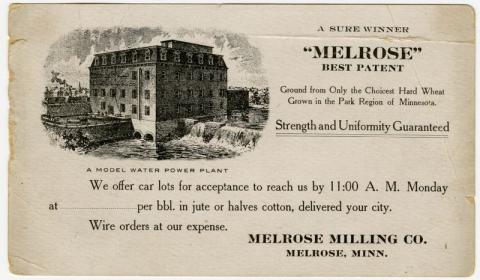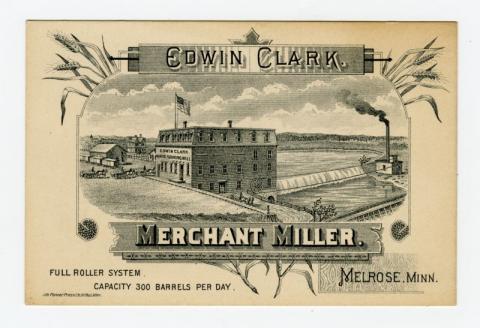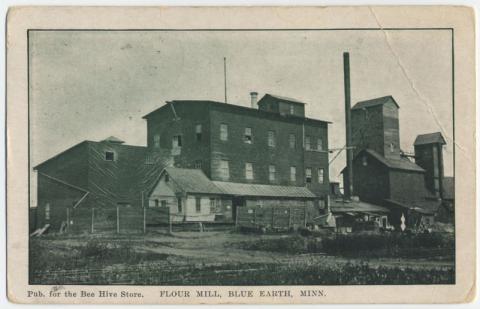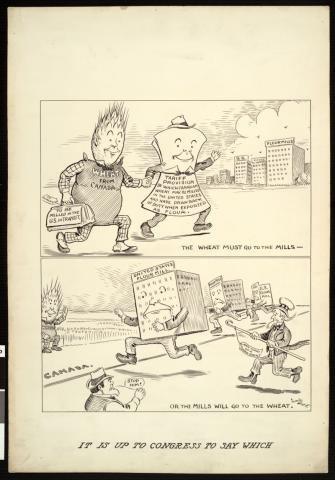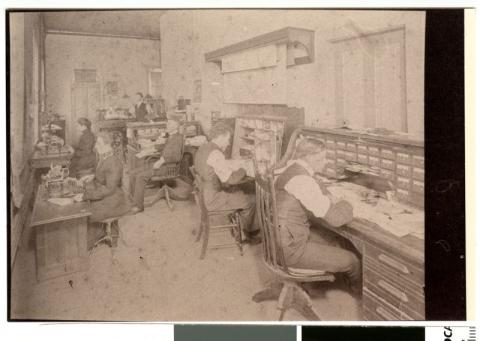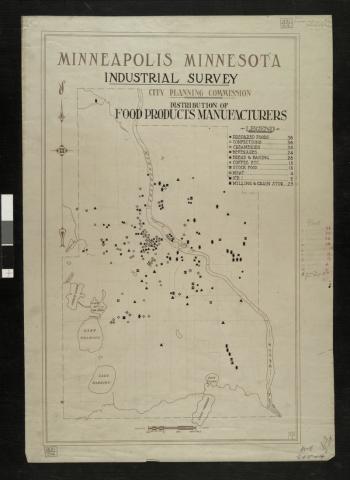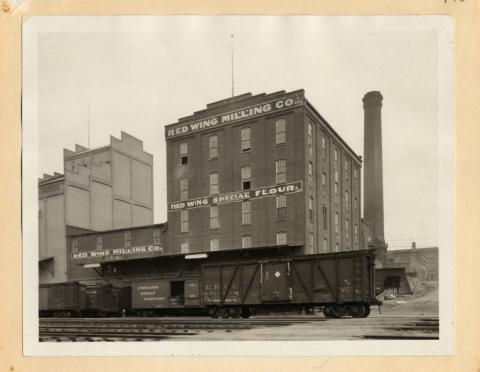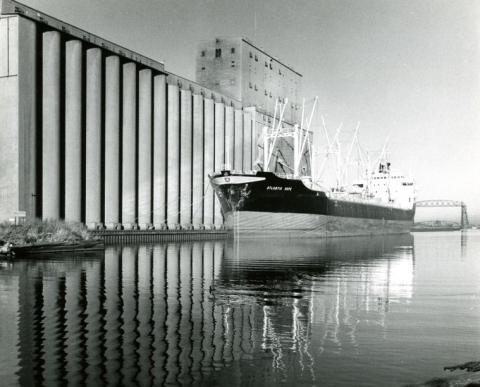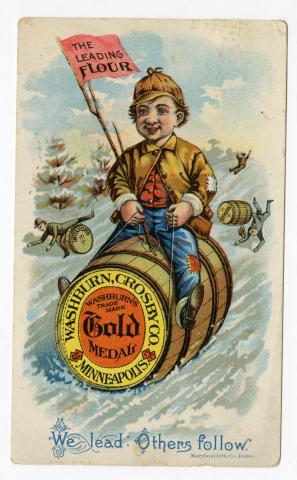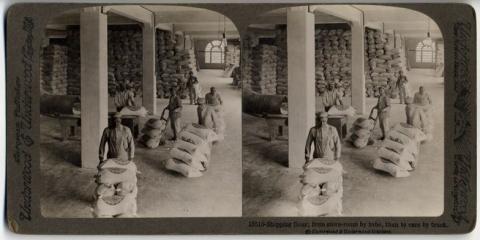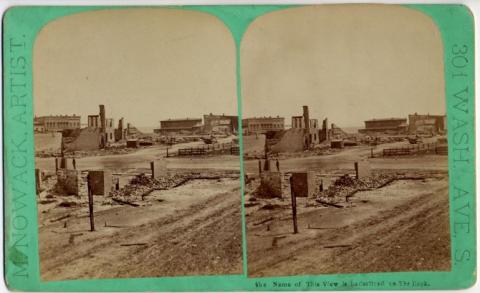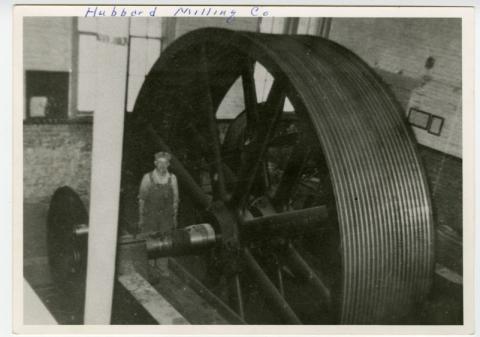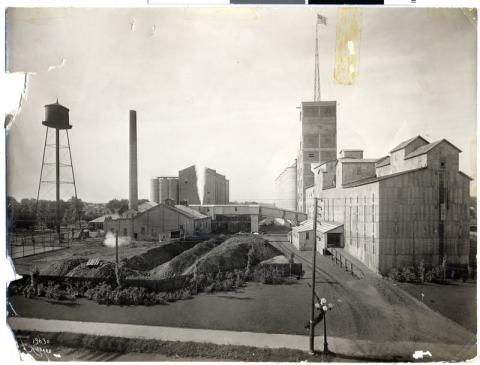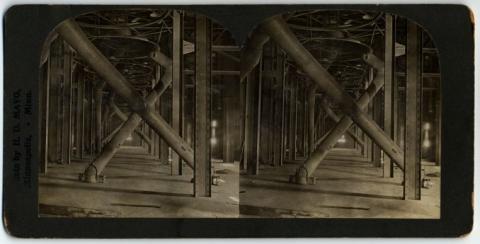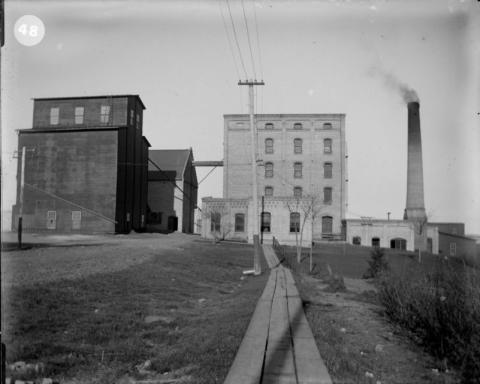Primary Source Set
by Abigail Raper, Intern, Minnesota Digital Library
Although Minnesota was a world-wide leader in the milling industry in the late 19th and early 20th centuries, milling got off to a slow start in the state. Wheat grown on the plains of the Dakotas and Canada was plentiful but difficult to process with available technology. However, the invention of the middlings purifier improved quality by separating husk from berry. Widely adopted by Minnesota millers, the middlings purifier gave a competitive edge. Now that flour could be milled profitably, companies sprung up alongside the waterpower of St. Anthony Falls. Some of the main companies included Washburn and Crosby (merged into General Mills in 1928), Pillsbury (bought by General Mills in 2001), and Northwestern Consolidated Milling.
A downside of the new technology was its propensity to create dust while processing. Enough eventually accumulated in the Washburn A Mill that caused the catastrophic explosion of 1878, killing eighteen. The rebuilt A Mill became safer with greater capacities. Washburn’s competitors followed suit in adopting the improved technology, allowing Minnesota to become a leading flour producer. In 1880, two million barrels of flour were produced—30 years later it jumped to 15.4 million barrels. The industry’s growth attracted new residents, many of whom immigrants. The workers’ arrival contributed to the tripling of Minneapolis's population from 1870 to 1890.
Although Minneapolis was bustling—known now as “Mill City”, it wasn’t the only site for milling activity. For example, Northfield was founded based on its river’s potential power to drive a mill. Other prominent cities for milling in the state included Melrose, Red Wing, Blue Earth, and Mankato.
Minnesota’s milling industry fed those in America and overseas during World War I. By 1916, the mills hit their peak of 18.5 million barrels produced—or the potential for 12 million loaves daily. Advances in milling affected other industries. Lumber milling built the flour mills and kickstarted local markets, thereby increasing the region’s economic growth. Railroads increased, such as connecting farms to mills and carrying many other products. Even culinary efforts shifted more to commercial baking. More land was dedicated to milling, turning plains to fields of gold (wheat) and greenery to factories. Peripheral industries were also affected, like barrel-making and breakfast-related foods.
Grain production and processing played a major role in the state’s economy for over 60 years. However, production soon decreased after WWI due to a number of factors, such as the Red River Valley’s decreased crop fertility and increase in trade regulations. Companies went out of business or merged. While Minnesota is no longer a flour milling capital, the legacy of milling and its importance here lingers.
Discussion Questions & Activities
1) After looking at the interior of Mankato Mills and reading through a few articles, what job roles are needed to run a mill?
2) What is the earliest date listed on the images? How do you think mills have changed to the latest date listed?
3) Looking at Melrose's cards, why do you think they were made? Can you make any modern-day connections?
4) Why was St. Anthony Falls important to milling? What is another Minnesota location that resembles it?
5) Why was milling an attractive job for some people? Was there a different importance from American-born and immigrants?
6) Were there any negative impacts to milling, such as environmentally and economically?
7) After reading about Mr. Pillsbury on MNopedia, what's a question you’d have for him?
eLibrary Minnesota Resources (for Minnesota residents)
1) Melouney, Carmel. “Deal of the Week: Making Art Out of Dough.” Wall Street Journal, 30 Oct. 2013, p. 6. ProQuest (accessed June 7, 2023).
2) Millett, Larry. “STREETSCAPES: Flour Milling Built a City of Mansions.” Star Tribune, 26 Aug. 2017. ProQuest (accessed June 7, 2023).
3) Nathanson, Iric. Images of America: The Minneapolis Riverfront. Arcadia Publishing, 2014. Mackinvia (accessed June 7, 2023).
Additional Resources for Research
1) “Forests, Fields, and the Falls: Flour Milling.” Minnesota Historical Society, Apr. 2023 (accessed June 7, 2023).
2) “Minneapolis Flour Milling Boom.” Minnesota Historical Society (accessed 7 June 2023).
3) “Wheat Farms, Flour Mills, and Railroads: A Web of Interdependence.” National Parks Service, 30 Mar. 2023 (accessed June 7, 2023).
4) Haidet, Mark. "Minneapolis Flour-Milling Industry During World War I." MNopedia, Minnesota Historical Society (accessed June 7, 2023).
5) Hess, Stephanie. “Milling in the Northfield Area Primary Source Set.” Northfield-Rice County Digital History Collection, 20 Oct. 2020 (accessed June 7, 2023)
6) Huber, Molly. "Pillsbury, Charles Alfred (1842–1899)." MNopedia, Minnesota Historical Society (accessed June 7, 2023).
7) Jessup, Molly. "Minneapolis Flour Mill Strike, 1903." MNopedia, Minnesota Historical Society. (accessed June 7, 2023).
8) Takuya Amagai, et al, “Legacy of Milling,” Minnesota Environments (accessed June 7, 2023).
9) Kuhlmann, Charles B. “The Influence of the Minneapolis Flour Mills upon the Economic Development of Minnesota and the Northwest.” Minnesota History, vol. 6, no. 2, 1925, pp. 141–54. JSTOR (accessed June 7, 2023).
10) Staats, Beth. “St. Anthony Falls.” Minnesota Digital Library, (accessed June 7, 2023).
Published onLast Updated on
